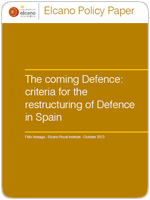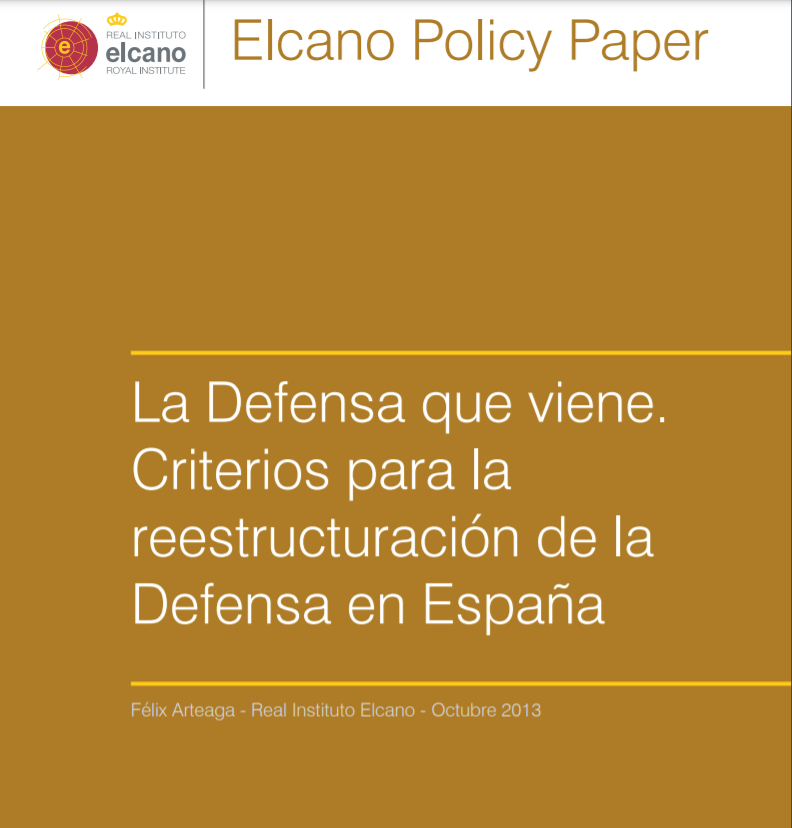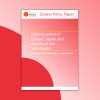Click ‘Download PDF’ to read the full Policy Paper.
Also available the Spanish version: ‘La Defensa que viene. Criterios para la reestructuración de la Defensa en España‘

Executive summary
The traditional Defence model in Western countries has been called into question with the disappearance of the geopolitical and geostrategic contexts for which it was designed. Its basic elements –scenarios for and ways of employing military force, the character and structure of the Armed Forces, the budgetary and industrial foundation and the strategic culture– are all rapidly changing because of the combined effect of structural processes stemming from globalisation and circumstantial ones related to the economic crisis affecting Western countries.
Both government and society as a whole must decide whether to maintain the traditional Defence model, prolonging its obsolescence, or undertake its renewal to adapt it to the changing structural trends. The Elcano Royal Institute supports the latter option and believes that Spain should reconsider the structural elements of its current Defence model.
In recent decades the global geopolitical context has changed dramatically (for the first time in 500 years, the geopolitical epicentre has shifted from the euro Atlantic region to Asia). Under globalisation, States are still the dominant strategic actors, but they are not the only ones, and they no longer hold a monopoly on the use of force, so they must find new ways of using their military capability (from polarity to networking). And they must diversify their options because, depending on their interests and national capabilities, they will have to act on an individual, bilateral or multilateral basis (States can no longer confront new risks on their own, but multilateral organisations cannot, either).
Because of this, there are new ways of using force while others are being abandoned
(from a global, land-based and massive projection of force we have shifted to
more limited and discreet forms of projection). While the maritime domain once again provides strategic flexibility, new domains of activity have appeared, such as space and cyberspace, in which the Armed Forces must act jointly and with new security actors, both public and private. Countries need to have a broad range of capabilities if they want to generate an adequate Joint Force tailored to the mission and able to operate jointly (from separate forces to a Joint Force).
The economic crisis has only worsened the budgetary problems associated with traditional Defence. Military budgets have been hit by an exponential increase in costs and a loss of priority with respect to other public policies (from necessary to affordable spending). As a result, the industrial base on which Western countries have built up their dominance of the world Defence market is being challenged by decreasing demand and the increasing offer (from economies of scale to the escalation of protectionism). Finally, the political and social perception of the utility and employment of military power has changed (from wars of necessity to wars of choice).
Spain’s Defence cannot avoid the structural trends expressed in ‘The Coming Defence’. With an eye to helping this system adapt, the Elcano Royal Institute proposes the following criteria for Defence restructuring in Spain:
- As a scenario for military action, prioritise the area encompassing the Maghreb and the Sahel regions, and from the Gulf of Guinea to the Horn of Africa, so as to defend our vital interests as laid out in the National Security Strategy of 2013 (from indiscriminate deployment to selective retrenchment).
- Diversify who we cooperate with and how, in order to make our capability for unilateral, bilateral and multilateral response more flexible (moving from alliances to coalitions, from exclusive organisations to inclusive networks and from ostensible allies to willing and able partners).
- Change the stance of the Armed Forces so as to create a tool that can be projected, giving Spain a real Joint Force that ensures it a permanent capability of area access and discreet force projection, preserve their combat capability and strengthen their capabilities associated with national security (moving towards a Joint Force).
- Plan meticulously (the sustainability criterion), spend wisely (the transformation criterion) and explain military expenditure in a convincing way (the communications criterion) so that the Defence budget can be consolidated and balanced (from budgetary insecurity to sustainable planning).
- Define an industrial policy that preserves the most competitive elements of the security and defence sectors and protects technologies deemed critical for national security (from Defence industry to defending a strategic industry).
- Frame the function of Defence within the new function of National Security and take advantage of the use of the Armed Forces in the new scenarios associated with security and defence so as to encourage a change in strategic culture (from the realm of National Defence to that of National Security).



